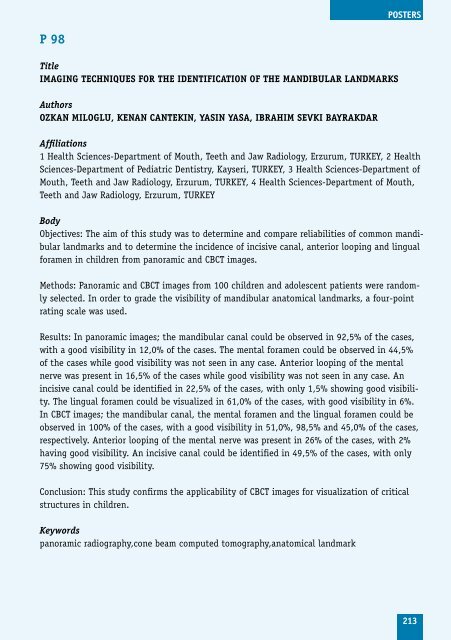Program including abstracts as pdf available here
Program including abstracts as pdf available here
Program including abstracts as pdf available here
You also want an ePaper? Increase the reach of your titles
YUMPU automatically turns print PDFs into web optimized ePapers that Google loves.
P 98<br />
Title<br />
IMAGING TECHNIQuES FOR THE IDENTIFICATION OF THE MANDIbuLAR LANDMARKS<br />
Authors<br />
OzKAN MILOGLu, KENAN CANTEKIN, yASIN yASA, IbRAHIM SEVKI bAyRAKDAR<br />
Affiliations<br />
1 Health Sciences-Department of Mouth, Teeth and Jaw Radiology, Erzurum, TURKEY, 2 Health<br />
Sciences-Department of Pediatric Dentistry, Kayseri, TURKEY, 3 Health Sciences-Department of<br />
Mouth, Teeth and Jaw Radiology, Erzurum, TURKEY, 4 Health Sciences-Department of Mouth,<br />
Teeth and Jaw Radiology, Erzurum, TURKEY<br />
Body<br />
Objectives: The aim of this study w<strong>as</strong> to determine and compare reliabilities of common mandibular<br />
landmarks and to determine the incidence of incisive canal, anterior looping and lingual<br />
foramen in children from panoramic and CBCT images.<br />
Methods: Panoramic and CBCT images from 100 children and adolescent patients were randomly<br />
selected. In order to grade the visibility of mandibular anatomical landmarks, a four-point<br />
rating scale w<strong>as</strong> used.<br />
Results: In panoramic images; the mandibular canal could be observed in 92,5% of the c<strong>as</strong>es,<br />
with a good visibility in 12,0% of the c<strong>as</strong>es. The mental foramen could be observed in 44,5%<br />
of the c<strong>as</strong>es while good visibility w<strong>as</strong> not seen in any c<strong>as</strong>e. Anterior looping of the mental<br />
nerve w<strong>as</strong> present in 16,5% of the c<strong>as</strong>es while good visibility w<strong>as</strong> not seen in any c<strong>as</strong>e. An<br />
incisive canal could be identified in 22,5% of the c<strong>as</strong>es, with only 1,5% showing good visibility.<br />
The lingual foramen could be visualized in 61,0% of the c<strong>as</strong>es, with good visibility in 6%.<br />
In CBCT images; the mandibular canal, the mental foramen and the lingual foramen could be<br />
observed in 100% of the c<strong>as</strong>es, with a good visibility in 51,0%, 98,5% and 45,0% of the c<strong>as</strong>es,<br />
respectively. Anterior looping of the mental nerve w<strong>as</strong> present in 26% of the c<strong>as</strong>es, with 2%<br />
having good visibility. An incisive canal could be identified in 49,5% of the c<strong>as</strong>es, with only<br />
75% showing good visibility.<br />
Conclusion: This study confirms the applicability of CBCT images for visualization of critical<br />
structures in children.<br />
Keywords<br />
panoramic radiography,cone beam computed tomography,anatomical landmark<br />
POSTerS<br />
213


